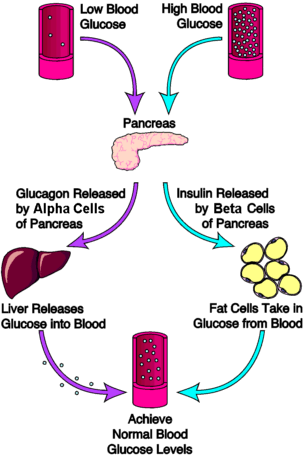What is Type 1 Diabetes?
When a “normal” person eats carbohydrates and other foods, glucose is produced and the beta cells in their pancreas release a hormone called insulin. The insulin allows the glucose to be carried through the blood and into the body’s cells, in order for it to be used as energy. Any left over glucose is stored in the liver as glycogen. This process stops the build up of glucose in the blood, thus regulating the body’s blood glucose level. In the same way, when the blood is running low on glucose the alpha cells in the pancreas release a hormone called glucagon. This forces the liver to release its stored glucose so the blood glucose levels are regulated back to normal.
Type 1 diabetes is an autoimmune disease which causes the body’s immune system to attack and destroy its beta cells. As a result, the pancreas is not able to produce insulin and the body is therefore unable to turn the glucose into energy.

What does this mean?
If Diabetes is left untreated a person’s blood glucose levels become too high and the consequences can potentially be fatal.
What are the symptoms of Type 1 Diabetes?
Symptoms can include, but not be limited to, any of the following:
– Extreme thirst
– Sudden weight loss
– Frequent urination
– Blurred vision
– Extreme tiredness
– Mood changes
– Vomiting
– Constant hunger
– Nausea
– Infections
– Tummy pains
– Acetone breath
If you, or someone you know, start to experience any of these symptoms please seek advice from a medical professional.
How is Type 1 Diabetes treated?
Most Type 1 Diabetics use insulin replacement therapy. This is usually in the form of daily injections or use of an insulin pump. They also have to regularly check their blood glucose levels by pricking their finger or using a continuous glucose monitor.


